Assessment of Soil Heavy Metal Pollution and Health Risks in Different Functional Areas on the Northern Slope of the Eastern Tianshan Mountains in Xinjiang, NW China
Abstract
1. Introduction
2. Materials and Methods
2.1. Study Area and Soil Sampling Collection
2.2. Laboratory Analysis
2.3. Geo-Accumulation Index
2.4. Single-Factor Pollution Index
2.5. Potential Ecological Risk Index
3. Results
3.1. Statistical Analysis of Heavy Metal Content in Soil
3.2. Assessment of Soil Heavy Metal Pollution in Different Functional Areas
3.2.1. Result of the Igeo
3.2.2. Result of the Pi
3.2.3. Result of the Potential Risk Index
3.3. Spatial Distribution of Heavy Metals in Different Functional Areas
3.4. Source Identification of Heavy Metals in Different Functional Areas
3.4.1. Pearson Correlation of Heavy Metals
3.4.2. Principal Component Analysis
3.4.3. Cluster Analysis
4. Discussion
4.1. Soil Heavy Metal Pollution Degree in Relation to Different Functional Areas
4.2. The Ecological Risk Degree and Source of Soil Heavy Metal Pollution in Different Functional Areas
5. Conclusions
Author Contributions
Funding
Institutional Review Board Statement
Informed Consent Statement
Data Availability Statement
Acknowledgments
Conflicts of Interest
References
- Maas, S.; Scheifler, R.; Benslama, M.; Crini, N.; Lucot, E.; Brahmia, Z.; Benyacoub, S.; Giraudoux, P. Spatial distribution of heavy metal concentrations in urban, suburban and agricultural soils in a Mediterranean city of Algeria. Environ. Pollut. 2010, 158, 2294–2301. [Google Scholar] [CrossRef]
- Ma, T.; Zhang, Y.; Hu, Q.; Han, M.; Li, X.; Zhang, Y.; Li, Z.; Shi, R. Accumulation Characteristics and Pollution Evaluation of Soil Heavy Metals in Different Land Use Types: Study on the Whole Region of Tianjin. Int. J. Environ. Res. Public Health 2022, 19, 10013. [Google Scholar] [CrossRef]
- Li, K.; Wang, J.Y.; Zhang, Y.W. Heavy metal pollution risk of cultivated land from industrial production in China: Spatial pattern and its enlightenment. Sci. Total Environ. 2022, 828, 154382. [Google Scholar] [CrossRef]
- Sun, T.; Huang, J.; Wu, Y.; Yuan, Y.; Xie, Y.; Fan, Z.; Zheng, Z. Risk Assessment and Source Apportionment of Soil Heavy Metals under Different Land Use in a Typical Estuary Alluvial Island. Int. J. Environ. Res. Public Health 2020, 17, 4841. [Google Scholar] [CrossRef]
- Chatterjee, A.; Banerjee, R.N. Determination of lead and other metals in a residential area of greater Calcutta. Sci. Total Environ. 1999, 277, 175–185. [Google Scholar] [CrossRef] [PubMed]
- Mcbride, M.B. Trace metals and sulfur in soils and forage of a chronic wasting disease locus. Environ. Chem. 2007, 4, 134–139. [Google Scholar] [CrossRef]
- Oskarsson, A.; Hallén, I.P.; Sundberg, J. Exposure to toxic elements via breast milk. Analyst 1995, 120, 6803–6812. [Google Scholar] [CrossRef] [PubMed]
- Liang, J.; Hua, S.; Zeng, G.; Yuan, Y.; Lai, X.; Li, X.; Yu, X. Application of weight method based on canonical correspondence analysis for assessment of Anatidae habitat suitability: A case study in East Dongting Lake, Middle China. Ecol. Eng. 2015, 77, 119–126. [Google Scholar] [CrossRef]
- Lu, A.; Wang, J.; Qin, X.; Wang, K.; Han, P.; Zhang, S. Multivariate and geostatistical analyses of the spatial distribution and origin of heavy metals in the agricultural soils in Shunyi, Beijing, China. Sci. Total Environ. 2012, 425, 66–74. [Google Scholar] [CrossRef]
- Huang, J.; Wu, Y.; Sun, J.; Li, X.; Geng, X.; Zhao, M.; Fan, Z. Health risk assessment of heavy metal (loid) s in park soils of the largest megacity in China by using Monte Carlo simulation coupled with positive matrix factorization model. J. Hazard. Mater. 2021, 415, 125629. [Google Scholar] [CrossRef]
- Le, D.V.; Giang, P.T.K.; Nguyen, V.T. Investigation of arsenic contamination in groundwater using hydride generation atomic absorption spectrometry. Environ. Monit. Assess. 2022, 195, 84. [Google Scholar] [CrossRef] [PubMed]
- Birkin, F.; Margerison, J.; Monkhouse, L. Chinese environmental accountability: Ancient beliefs, science and sustainability. Resour. Environ. Sustain. 2021, 3, 100017. [Google Scholar] [CrossRef]
- Yang, Z.; Zhang, R.; Li, H.; Zhao, X.; Liu, X. Heavy Metal Pollution and Soil Quality Assessment under Different Land Uses in the Red Soil Region, Southern China. Int. J. Environ. Res. Public Health 2022, 19, 4125. [Google Scholar] [CrossRef] [PubMed]
- Wang, C.; Wang, Z.; Gao, Y.; Zhang, X. Planular-vertical distribution and pollution characteristics of cropland soil Hg and the estimated soil–air exchange fluxes of gaseous Hg over croplands in northern China. Environ. Res. 2021, 195, 110810. [Google Scholar] [CrossRef] [PubMed]
- Qi, C.; Xu, X.; Chen, Q.; Liu, H.; Min, X.; Fourie, A.; Chai, L. Ab initio calculation of the adsorption of As, Cd, Cr, and Hg heavy metal atoms onto the illite (001) surface: Implications for soil pollution and reclamation. Environ. Pollut. 2022, 312, 120072. [Google Scholar] [CrossRef]
- Abliz, A.; Shi, Q.; Abulizi, A. Contamination Status and Health Risk Assessment of Soil Heavy Metals in the Northern Slope of Eastern Tianshan Mountains Industrial Belt in Xinjiang, Northwest China. Forests 2022, 13, 1914. [Google Scholar] [CrossRef]
- Chrastny, V.; Komarek, M.; Prochazka, J.; Pechar, L.; Vanek, A.; Penizek, V.; Farkas, J. 50 years of different landscape management influencing retention of metals in soils. J. Geochem. Explor. 2012, 115, 59–68. [Google Scholar] [CrossRef]
- Imperato, M.; Adamo, P.; Naimo, D.; Arienzo, M.; Stanzione, D.; Violante, P. Spatial distribution of heavy metals in urban soils of Naples city (Italy). Environ. Pollut. 2003, 124, 247–256. [Google Scholar] [CrossRef]
- Pavao-Zuckerman, M.A.; Byrne, L.B. Scratching the surface and digging deeper: Exploring ecological theories in urban soils. Urban Ecosystems. 2009, 12, 9–20. [Google Scholar] [CrossRef]
- Zhang, P.P. Urban Comprehensive Carrying Capacity Evaluation of Economic Belt of Tianshan North-Slope. Master’s Thesis, Shihezi University, Shihezi, China, 2015; p. 25. [Google Scholar]
- Wang, F.; Guan, Q.; Tian, J.; Lin, J.; Yang, Y.; Yang, L.; Pan, N. Contamination characteristics, source apportionment, and health risk assessment of heavy metals in agricultural soil in the Hexi Corridor—Science Direct. CATENA 2020, 191, 104573. [Google Scholar] [CrossRef]
- Wu, W.; Qu, S.; Nel, W.; Ji, J. The influence of natural weathering on the behavior of heavy metals in small basaltic watersheds: A comparative study from different regions in China. Chemosphere 2021, 262, 127897. [Google Scholar] [CrossRef]
- Zhang, S.Q.; Zhang, Y.; Ma, Y.P.; Pu, Z.C.; Li, X.J.; Meng, F.X. Precipitation Characteristics and Its Influence on Maturation Period of Wine Grape on the Northern Slope of Tianshan Mountains in Xinjiang. Desert Oasis Meteorol. 2021, 15, 132–138. [Google Scholar]
- Tian, H.; Liu, L.; Zhang, Z.; Ning, S.; Kang, Z.W.; Wang, T.X. Evaluation on the critical ecological space of the economic belt of Tianshan north slope. Acta Ecologic. Sini. 2021, 41, 401–414. [Google Scholar]
- Chen, X.; Shi, Y.X.; Zhao, Y.W. Assessments on Potential Resources of Deep Coalbed Methane on South of Fukang Syncline, Fukang Western Mining Area. Chin. Inn. Mong. Petrochem. Ind. 2017, 43, 47–49. [Google Scholar]
- Li, Q. Study on Heavy Metals Pollution of top Soil and Cropper in Thenorthern Slope of Tianshan Mountains. Master’s Thesis, Shihezi University, Shihezi, China, 2017. [Google Scholar]
- Zhang, H.; Zhang, F.; Xia, N. Correlation analysis and Spatial distribution of soil heavy metals with different regions in Zhundong area. Chin. China Min. Mag. 2017, 26, 74–80. [Google Scholar]
- Muller, G. Die Schwermetallbelstung der sedimente des Neckars und seiner Nebenflusse: Eine Bestandsaufnahme. Chem. Ztg. 1981, 105, 157–164. [Google Scholar]
- Liu, J.; Kang, H.; Tao, W.; Li, H.; He, D.; Ma, L.; Tang, H.; Wu, S.; Yang, K.; Li, X. A spatial distribution—Principal component analysis (SD-PCA) model to assess pollution of heavy metals in soil. Sci. Total Environ. 2022, 11, 160112. [Google Scholar] [CrossRef] [PubMed]
- Abliz, A.; Shi, Q. Ecological risk assessment of toxic metal pollution in the industrial zone on the northern slope of the East Tianshan Mountains in Xinjiang, NW China. Open Geosci. 2021, 13, 582–593. [Google Scholar] [CrossRef]
- Liu, C.; Lu, L.; Huang, T.; Huang, Y.; Ding, L.; Zhao, W. The Distribution and Health Risk Assessment of Metals in Soils in the Vicinity of Industrial Sites in Dongguan, China. Int. J. Environ. Res. Public Health 2016, 13, 832. [Google Scholar] [CrossRef]
- Hakanson, L. An ecological risk index for aquatic pollution Control a sedimentological approach. Water Res. 1980, 14, 975–1001. [Google Scholar] [CrossRef]
- Zhao, L.; Xu, Y.; Hou, H.; Shangguan, Y.; Li, F. Source identification and health risk assessment of metals in urban soils around the Tanggu chemical industrial district, Tianjin, China. Sci. Total Environ. 2014, 468–469, 654–662. [Google Scholar] [CrossRef]
- Cai, L.Q.; Yeboah, S.; Sun, C.S. GIS-based assessment of arable layer pollution of copper (Cu), zinc (Zn)and lead (Pb) in Baiyin District of Gansu Province. Environ. Earth Sci. 2015, 74, 803–811. [Google Scholar]
- GB15618-2018; Environmental Quality Standards for Soil. MEP-PRC: Beijing, China, 2018.
- Li, P.; Lin, C.; Cheng, H.; Duan, X.; Lei, K. Contamination and health risks of soil heavy metals around a lead/zinc smelter in southwestern China. Ecotoxicol. Environ. Saf. 2015, 113, 391–399. [Google Scholar] [CrossRef]
- Zhan, J.; Wu, C.; Ma, X.; Yang, C.; Miao, Q.; Wang, S. Abnormal vibration detection of wind turbine based on temporal convolution network and multivariate coefficient of variation. Mech. Syst. Signal Process. 2022, 174, 109082. [Google Scholar] [CrossRef]
- Wang, F.; Wang, F.; Yang, H. Ecological risk assessment based on soil adsorption capacity for heavy metals in taihu basin. China Environ. Pollut. 2022, 5, 120608. [Google Scholar] [CrossRef]
- Wang, H.C.; Yang, J.; Lin, H.P. Application of RBF networks in mercury pollution spatial prediction of a gold mine area. Advanc. Mater. Res. 2014, 926/930, 2771–2776. [Google Scholar] [CrossRef]
- Chai, L.; Wang, Y.H.; Wang, X.; Ma, L.; Cheng, Z.; Su, L. Pollution characteristics, spatial distributions, and source apportionment of heavy metals in cultivated soil in Lanzhou, China. Ecol. Indi. 2021, 125, 107507. [Google Scholar] [CrossRef]
- Chowdhury, A.; Maiti, S.K. Identification of metal tolerant plant species in mangrove ecosystem by using community study and multivariate analysis: A case study from Indian Sunderban. Environ. Earth Sci. 2016, 75, 744. [Google Scholar] [CrossRef]
- Trifi, M.; Gasmi, A.; Carbone, C.; Majzlan, J.; Nasri, N.; Dermech, M.; Charef, A.; Elfil, H. Machine learning-based prediction of toxic metals concentration in an acid mine drainage environment, northern Tunisia. Environ. Sci. Pollut. Res. 2022, 29, 87490–87508. [Google Scholar] [CrossRef]
- Cheng, X.; Danek, T.; Drozdova, J.; Huang, Q.; Qi, W.; Zou, L.; Xiang, Y. Soil heavy metal pollution and risk assessment associated with the Zn-Pb mining region in Yunnan, Southwest China. Environ. Monit. Assess. 2018, 190, 194. [Google Scholar] [CrossRef]
- Zhang, J.; Ji, G.; Xu, L.; Kong, G.; Wang, J.; Lan, X.; Tian, B. Application of principal component analysis in vegetable soil and water pollution. In Proceedings of the Conference on Environmental Pollution and Public Health, Wuhan, China, 16–17 September 2011; pp. 521–526. [Google Scholar]
- Mamat, Z.; Yimit, H.; Ji, R.Z.A.; Eziz, M. Source identification and hazardous risk delineation of heavy metal contamination in Yanqi basin, northwest China. Sci. Total Environ. 2014, 493, 1098–1111. [Google Scholar] [CrossRef] [PubMed]
- Liu, W.; Yang, J.J.; Wang, J.; Wang, G.; Gao, Y.E. Contamination Assessment and Sources Analysis of Soil Heavy Metals in Opencast Mine of East Junggar Basin in Xinjiang. Chin. Environ. Sci. 2016, 37, 1938–1945. [Google Scholar]
- Hu, X.H.; Zhang, L.; Kong, L.F.; Wang, T.Q. Studies on Pollution Risks of Heavy Metals in Dustfall, Soil and Plant around the Opencast Coal Mines in Eastern Junggar Basin in Xinjiang. Chin. Environ. Prot. Xinjiang 2020, 42, 24–32. [Google Scholar]
- Zhao, F.J.; Ma, Y.; Zhong, T.; Mcgrath, S.P. Soil contamination in China: Current status and mitigation strategies. Environ. Sci. Technol. 2015, 49, 750–759. [Google Scholar] [CrossRef] [PubMed]
- Zhang, H.; Yin, S.; Chen, Y.; Shao, S.; Wu, J.; Fan, M.; Chen, F.; Gao, C. Machine learning-based source identification and spatial prediction of heavy metals in soil in a rapid urbanization area, eastern China. J. Clean. Prod. 2020, 273, 122858. [Google Scholar] [CrossRef]
- Li, C.; Zhang, G.S.; Yao, F. Assessment of soil heavy metal pollution in area of Xinjiang Zhundong Wucaiwan surface coal mine. Environ. Eng. 2014, 32, 142–146. [Google Scholar]
- Hu, H.J.; Han, L.; Li, L.; Wang, H.; Xu, T. Soil heavy metal pollution source analysis based on the land use type in Fengdong District of Xi’an, China. Environ. Monit. Assess. 2021, 193, 643. [Google Scholar] [CrossRef]
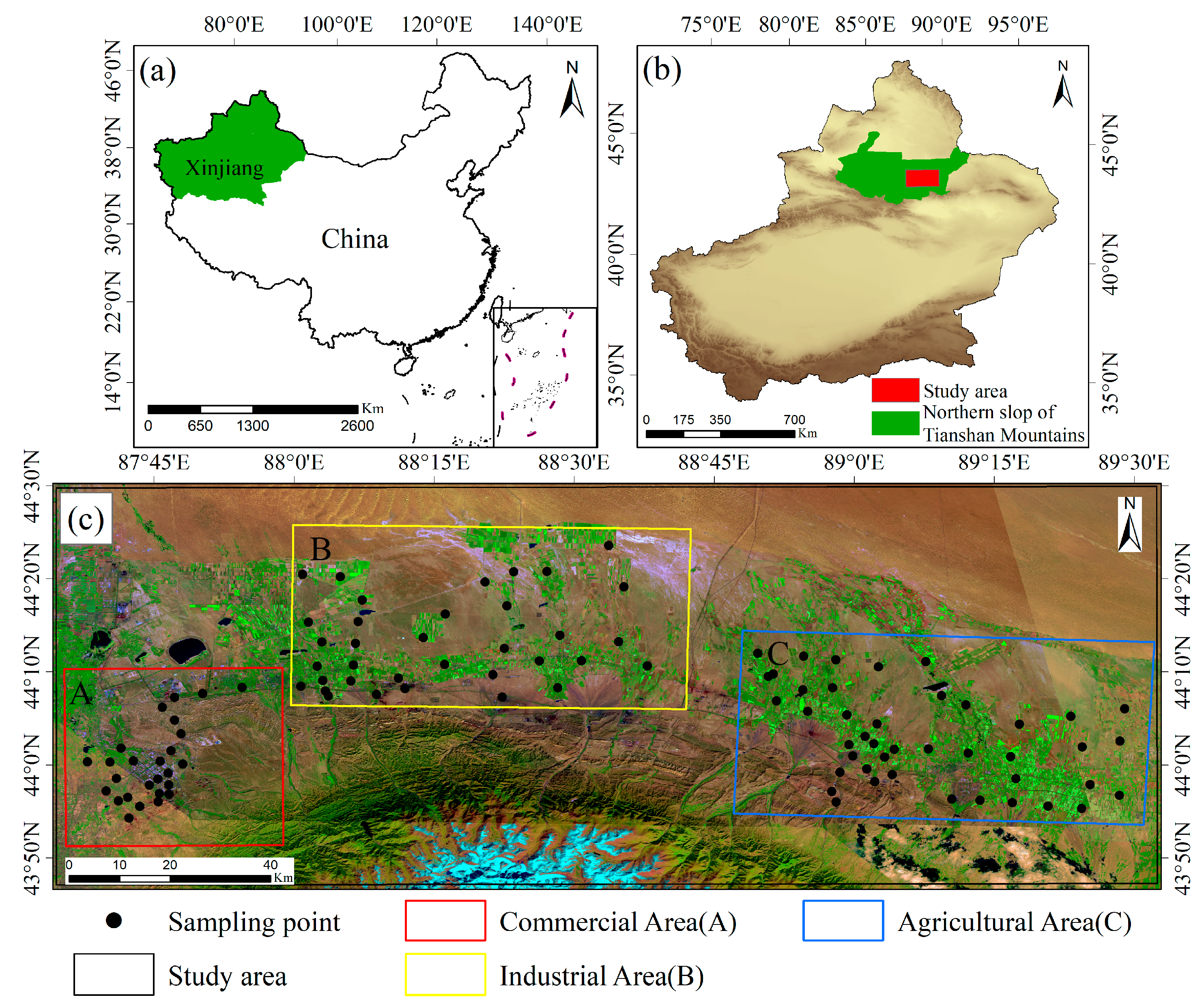
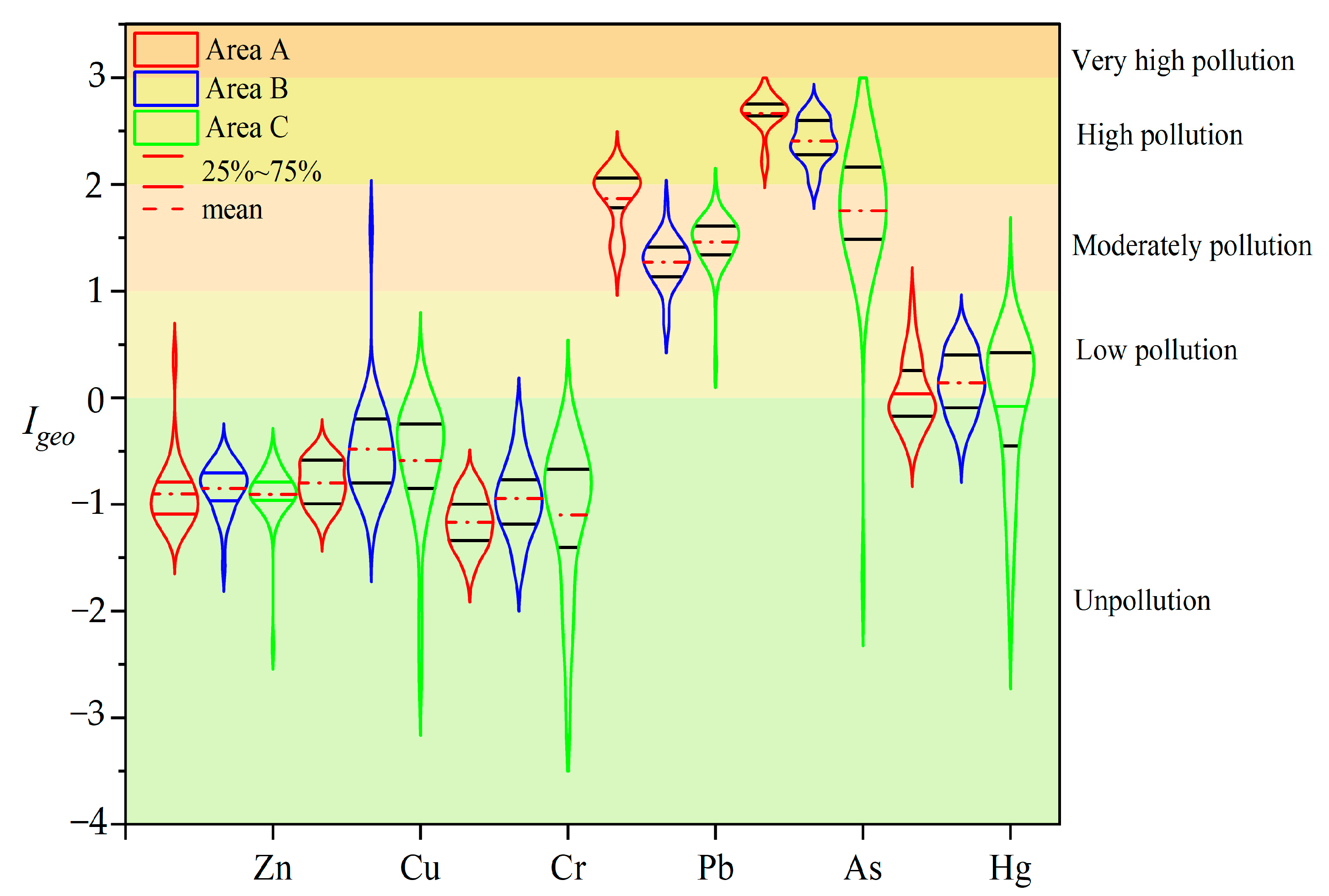
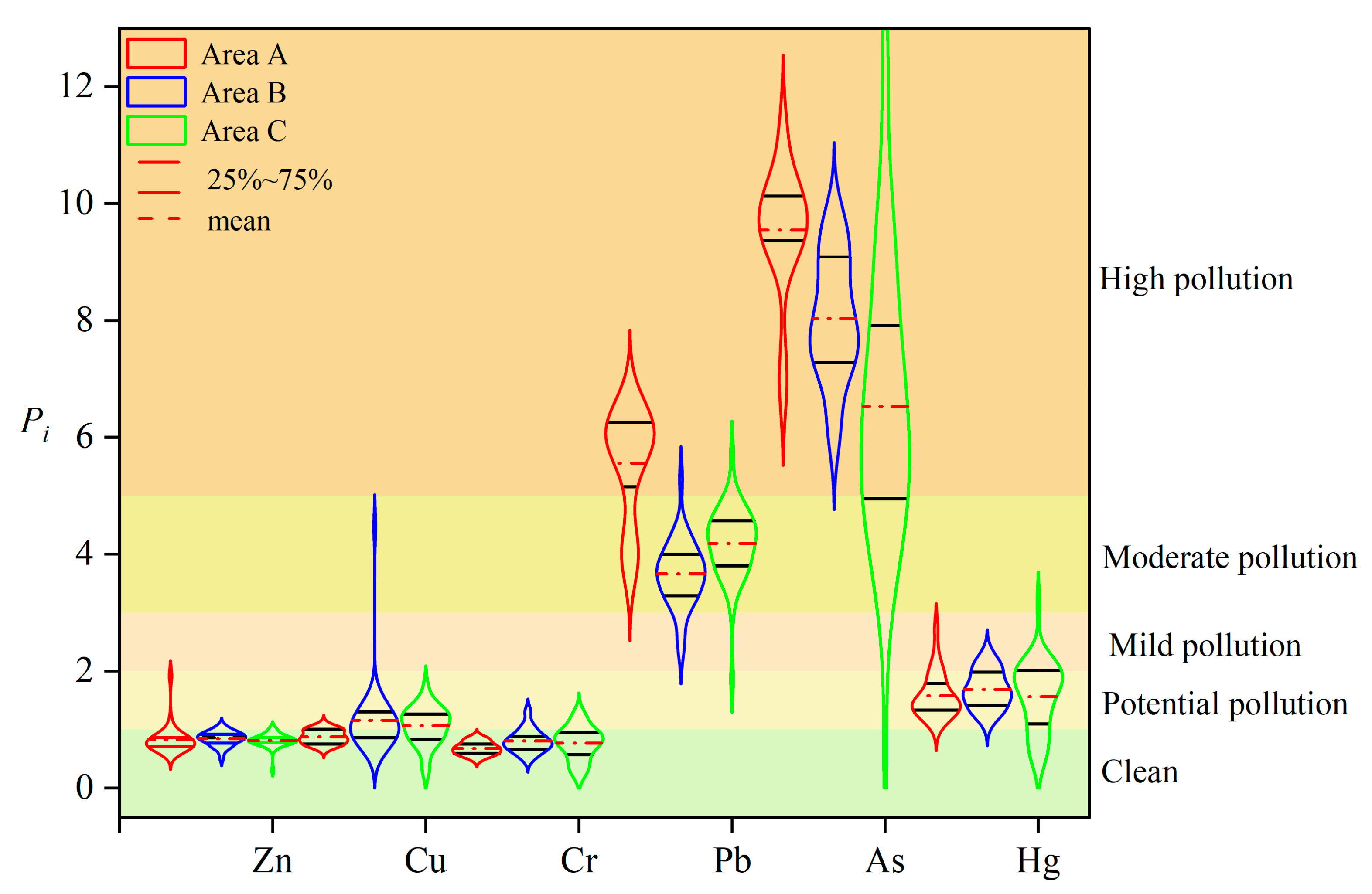

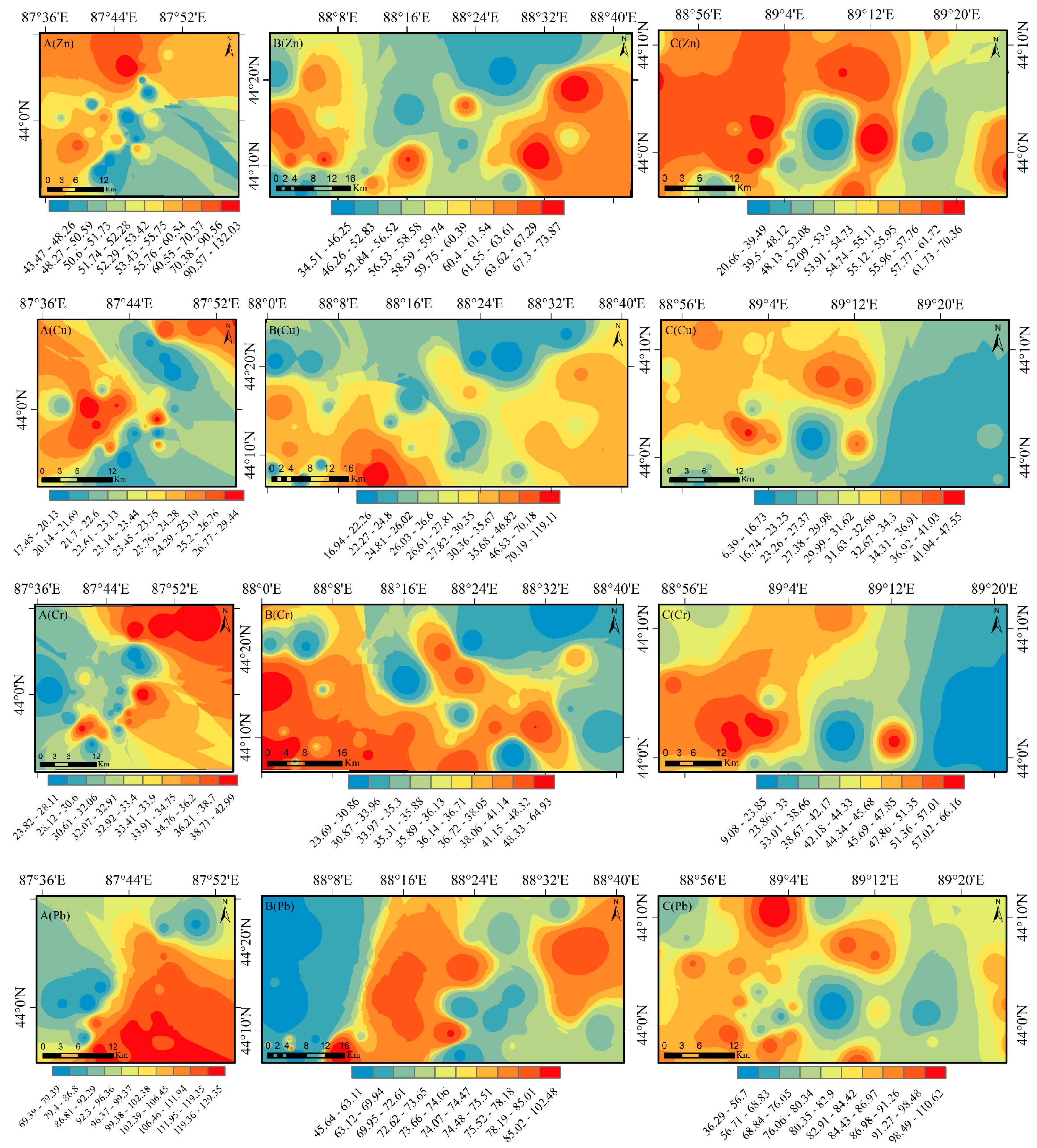
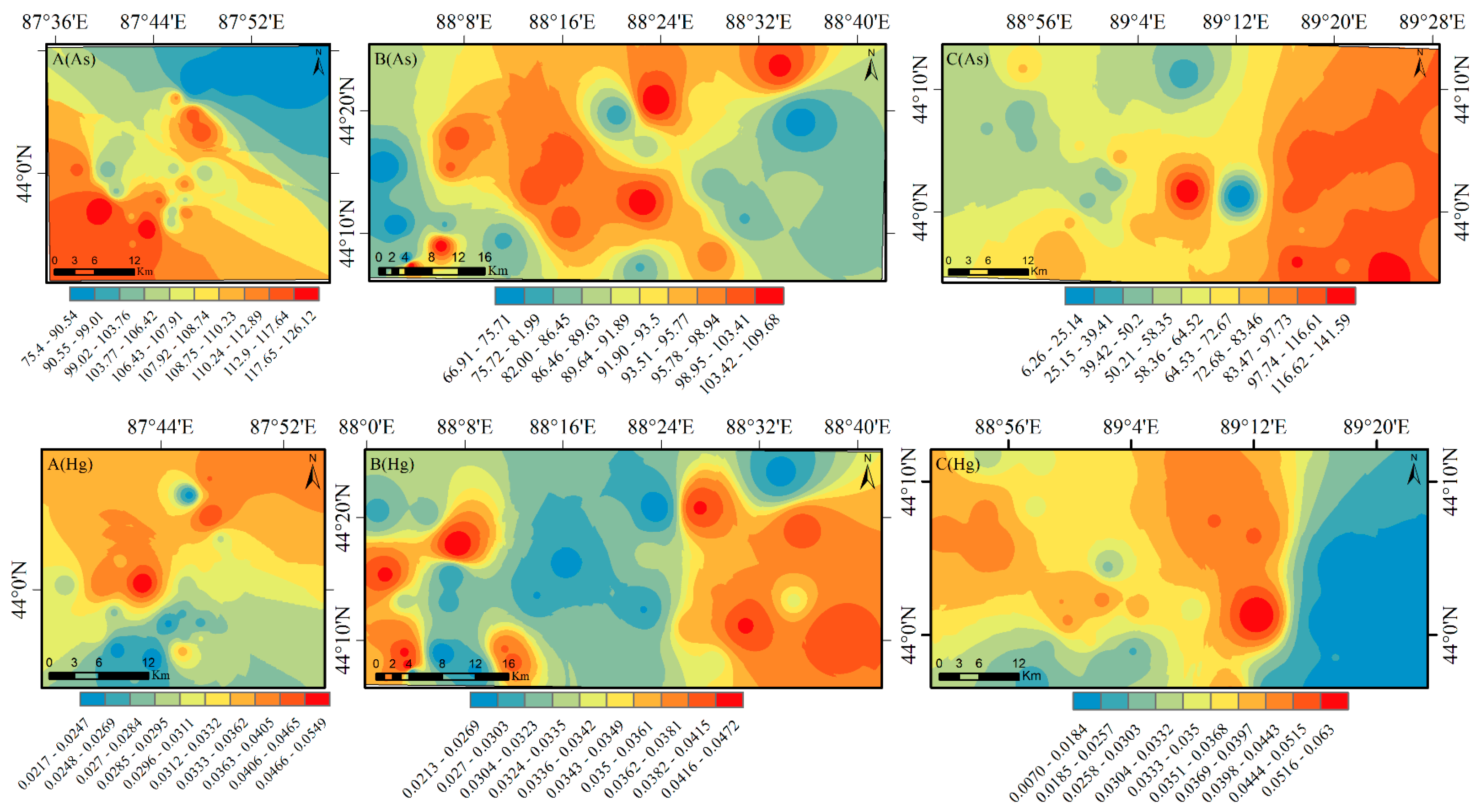
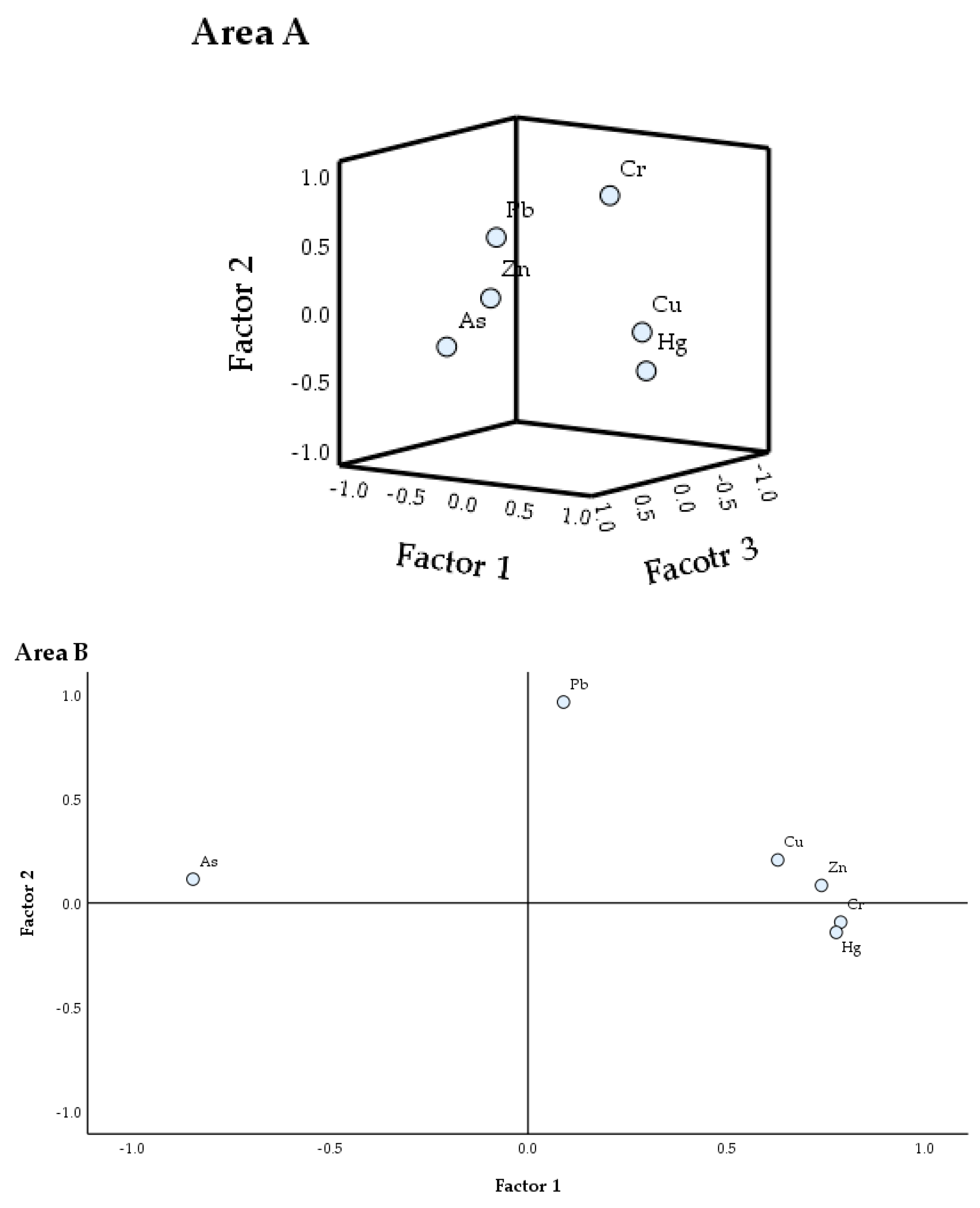
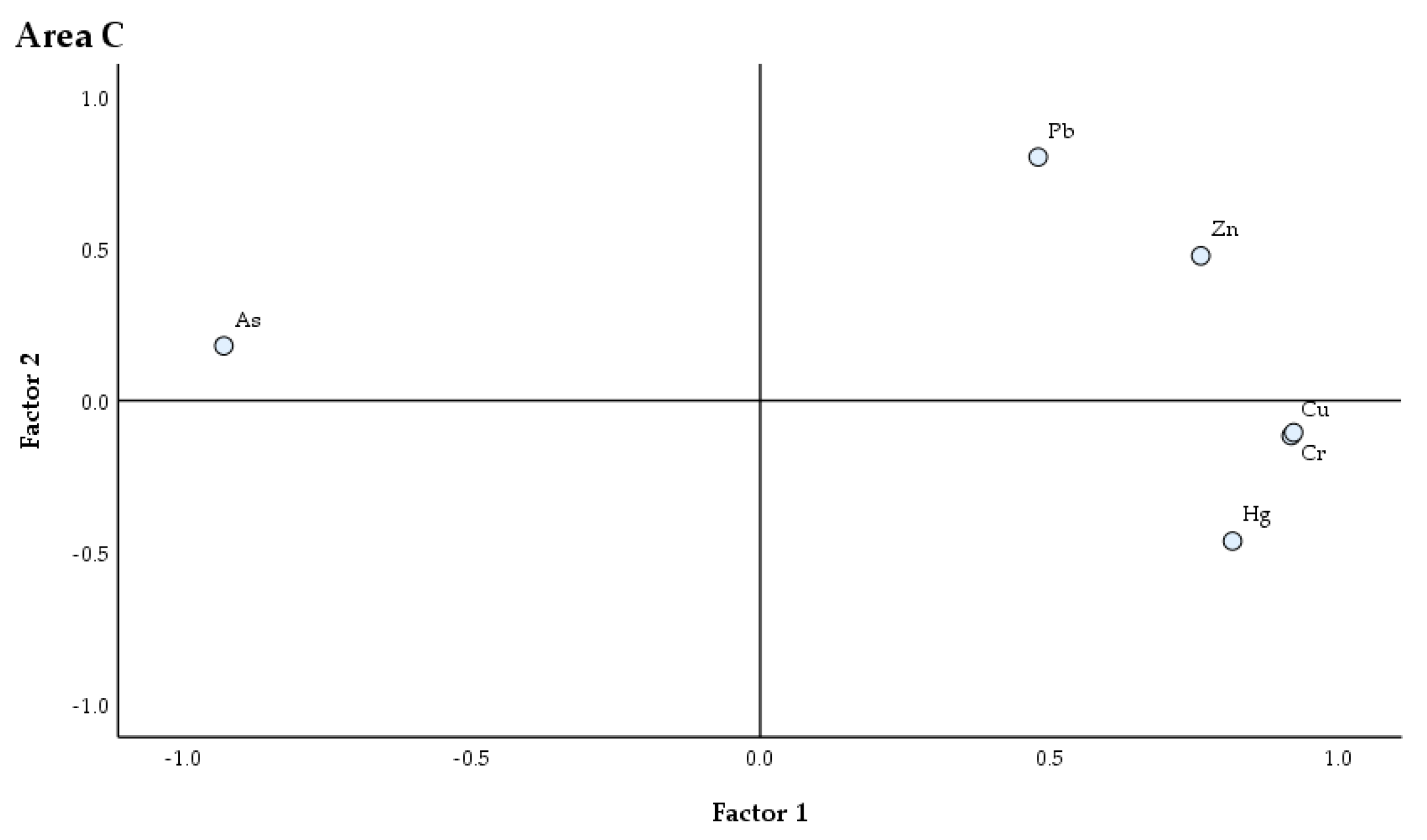
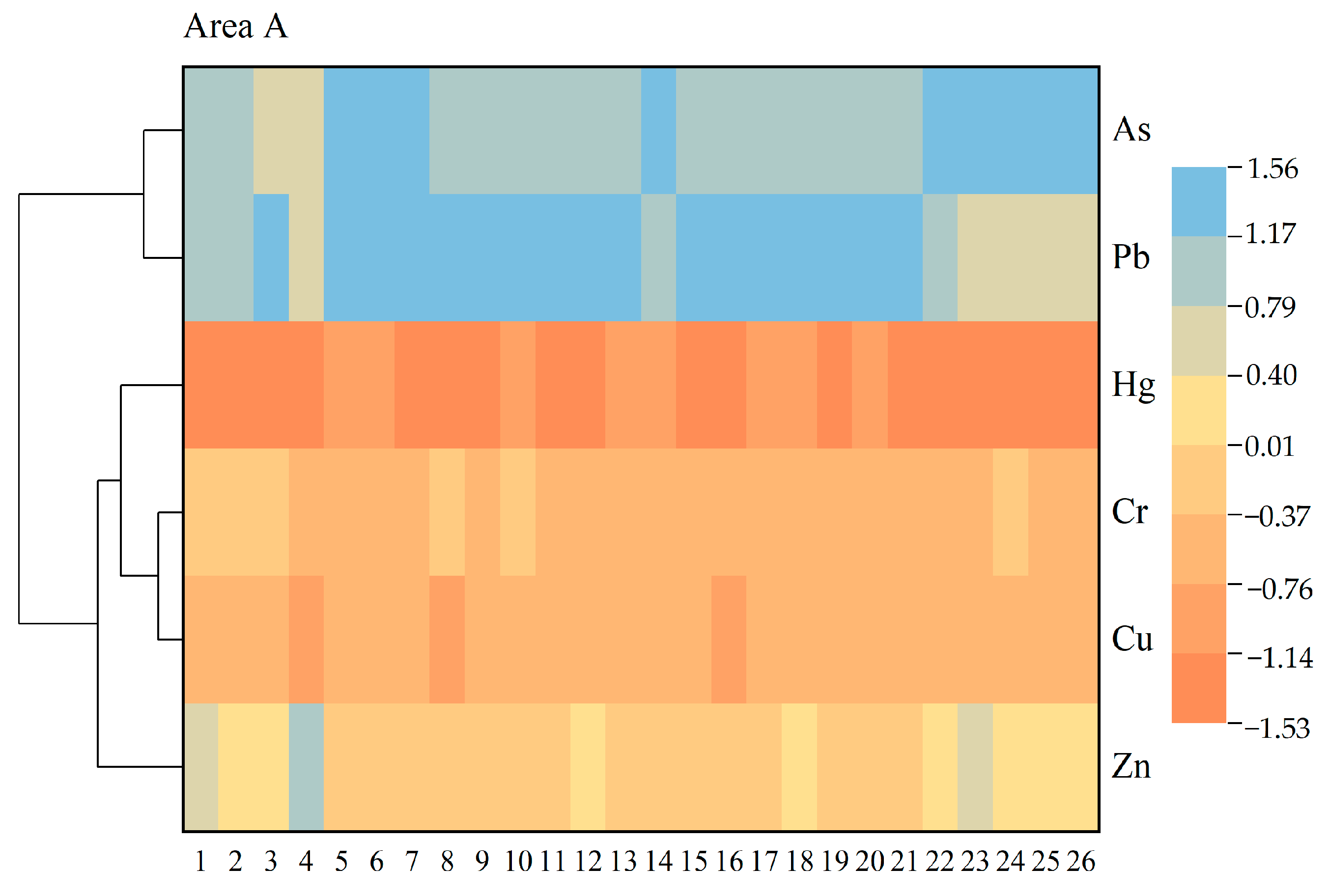

| Ranges of Pi | 1 | 2 | 3 | 4 | 5 |
|---|---|---|---|---|---|
| Pollution level | Pi ≤ 1 | 1 < Pi ≤ 2 | 2 < Pi ≤ 3 | 3 < Pi ≤ 5 | Pi > 5 |
| level | Clean | Potential pollution | Mild pollution | Moderate pollution | Heavy pollution |
| <40 | 40–80 | 80–160 | 160–320 | >320 | |
|---|---|---|---|---|---|
| Ranges of PRI | <90 | 90–180 | 180–360 | 360–720 | >720 |
| Ecological risk levels | Low risk | Moderate risk | Considerable risk | High risk | Very high risk |
| Area | Elements | Ranges | Mean Value± SD a | CV b | Skewness | Kurtosis | Background Values c | Standard Level d |
|---|---|---|---|---|---|---|---|---|
| (mg·kg−1) | (mg·kg−1) | (%) | (mg·kg−1) | (mg·kg−1) | ||||
| Area A | Zn | 43.44~132.06 | 56.97 ± 16.87 | 29.61 | 3.59 | 15.28 | 68.8 | 300 |
| Cu | 17.44~29.44 | 23.27 ± 3.21 | 13.79 | 0.08 | −1.06 | 26.7 | 100 | |
| Cr | 23.81~43.00 | 33.33 ± 5.30 | 15.91 | 0.18 | −0.86 | 49.3 | 250 | |
| Pb | 69.38~129.38 | 107.87 ± 18.05 | 16.73 | −0.99 | −0.45 | 19.4 | 170 | |
| As | 75.38~126.13 | 106.91 ± 11.88 | 11.11 | −1.28 | 2.14 | 11.2 | 20 | |
| Hg | 0.02~0.05 | 0.03 ± 0.01 | 23.92 | 1.41 | 2.14 | 0.02 | 1.0 | |
| Area B | Zn | 34.31~73.88 | 58.00 ± 8.41 | 14.50 | −0.63 | 0.63 | 68.8 | 300 |
| Cu | 16.81~119.19 | 30.82 ± 16.35 | 53.05 | 4.67 | 25.05 | 26.7 | 100 | |
| Cr | 23.69~64.94 | 39.56 ± 9.57 | 24.19 | 0.84 | 0.82 | 49.3 | 250 | |
| Pb | 45.63~102.50 | 70.98 ± 10.76 | 15.16 | 0.15 | 1.48 | 19.4 | 170 | |
| As | 66.88~109.69 | 89.93 ± 11.74 | 13.05 | −0.06 | −0.70 | 11.2 | 20 | |
| Hg | 0.02~0.05 | 0.03 ± 0.01 | 19.38 | 0.21 | −0.78 | 0.02 | 1.0 | |
| Area C | Zn | 20.63~70.38 | 55.80 ± 7.84 | 14.04 | −1.83 | 8.51 | 68.8 | 300 |
| Cu | 6.38~47.56 | 28.34 ± 8.67 | 30.59 | −0.45 | 0.34 | 26.7 | 100 | |
| Cr | 9.06~66.19 | 37.80 ± 14.12 | 37.35 | −0.23 | −0.50 | 49.3 | 250 | |
| Pb | 36.25~110.63 | 81.19 ± 11.98 | 14.76 | −0.97 | 3.73 | 19.4 | 170 | |
| As | 6.19~141.63 | 73.09 ± 27.11 | 37.10 | 0.45 | 0.65 | 11.2 | 20 | |
| Hg | 0.01~0.06 | 0.03 ± 0.01 | 37.95 | −0.17 | −0.01 | 0.02 | 1.0 |
| Area | Element | Zn | Cu | Cr | Pb | As | Hg |
|---|---|---|---|---|---|---|---|
| Area A | Zn | 1.00 | |||||
| Cu | 0.06 | 1.00 | |||||
| Cr | 0.10 | 0.21 | 1.00 | ||||
| Pb | –0.15 | –0.49 | –0.01 | 1.00 | |||
| As | –0.002 | –0.49 | –0.53 | 0.35 | 1.00 | ||
| Hg | –0.06 | 0.45 | 0.01 | –0.46 | –0.44 | 1.00 | |
| Area B | Zn | 1.00 | |||||
| Cu | 0.38 | 1.00 | |||||
| Cr | 0.45 | 0.40 | 1.00 | ||||
| Pb | 0.09 | 0.11 | 0.02 | 1.00 | |||
| As | –0.58 | –0.37 | –0.58 | –0.01 | 1.00 | ||
| Hg | 0.41 | 0.35 | 0.54 | 0.01 | –0.62 | 1.00 | |
| Area C | Zn | 1.00 | |||||
| Cu | 0.66 | 1.00 | |||||
| Cr | 0.59 | 0.80 | 1.00 | ||||
| Pb | 0.61 | 0.32 | 0.39 | 1.00 | |||
| As | –0.62 | –0.84 | –0.85 | –0.29 | 1.00 | ||
| Hg | 0.36 | 0.76 | 0.79 | 0.09 | –0.80 | 1.00 |
| Areas | Element | Initial Eigenvalues | Rotated Eigenvalues | After Rotated Component Matrix | ||||||
|---|---|---|---|---|---|---|---|---|---|---|
| Total | Variance% | Cumulative% | Total | Variance% | Cumulative% | PC1 | PC2 | PC3 | ||
| Area A | Zn | 2.45 | 40.87 | 40.87 | 2.45 | 40.87 | 40.87 | 0.11 | 0.21 | 0.95 |
| Cu | 1.22 | 20.26 | 61.13 | 1.22 | 20.26 | 61.13 | 0.79 | −0.12 | 0.03 | |
| Cr | 1.04 | 17.36 | 78.49 | 1.04 | 17.36 | 78.49 | 0.42 | 0.84 | −0.10 | |
| Pb | 0.52 | 8.72 | 87.22 | −0.70 | 0.40 | −0.27 | ||||
| As | 0.47 | 7.75 | 94.97 | −0.80 | −0.35 | 0.20 | ||||
| Hg | 0.30 | 5.04 | 100 | 0.70 | −0.42 | −0.15 | ||||
| Area B | Zn | 2.90 | 48.27 | 48.27 | 2.90 | 48.27 | 48.27 | 0.74 | 0.09 | |
| Cu | 1.03 | 17.09 | 65.36 | 1.03 | 17.09 | 65.36 | 0.63 | 0.21 | ||
| Cr | 0.69 | 11.54 | 76.91 | 0.79 | −0.09 | |||||
| Pb | 0.60 | 10.01 | 86.92 | 0.09 | 0.97 | |||||
| As | 0.46 | 7.63 | 94.54 | −0.85 | 0.12 | |||||
| Hg | 0.33 | 5.46 | 100.00 | 0.78 | −0.14 | |||||
| Area C | Zn | 4.04 | 67.38 | 67.38 | 4.04 | 67.38 | 67.38 | 0.76 | 0.48 | |
| Cu | 1.15 | 19.12 | 86.51 | 1.15 | 19.12 | 86.51 | 0.92 | −0.12 | ||
| Cr | 0.37 | 6.11 | 92.61 | 0.92 | −0.11 | |||||
| Pb | 0.17 | 2.84 | 95.45 | 0.48 | 0.80 | |||||
| As | 0.15 | 2.46 | 97.91 | −0.93 | 0.18 | |||||
| Hg | 0.13 | 2.09 | 100.00 | 0.82 | −0.46 | |||||
Disclaimer/Publisher’s Note: The statements, opinions and data contained in all publications are solely those of the individual author(s) and contributor(s) and not of MDPI and/or the editor(s). MDPI and/or the editor(s) disclaim responsibility for any injury to people or property resulting from any ideas, methods, instructions or products referred to in the content. |
© 2023 by the authors. Licensee MDPI, Basel, Switzerland. This article is an open access article distributed under the terms and conditions of the Creative Commons Attribution (CC BY) license (https://creativecommons.org/licenses/by/4.0/).
Share and Cite
Asaiduli, H.; Abliz, A.; Abulizi, A.; Sun, X.; Ye, P. Assessment of Soil Heavy Metal Pollution and Health Risks in Different Functional Areas on the Northern Slope of the Eastern Tianshan Mountains in Xinjiang, NW China. Int. J. Environ. Res. Public Health 2023, 20, 4843. https://doi.org/10.3390/ijerph20064843
Asaiduli H, Abliz A, Abulizi A, Sun X, Ye P. Assessment of Soil Heavy Metal Pollution and Health Risks in Different Functional Areas on the Northern Slope of the Eastern Tianshan Mountains in Xinjiang, NW China. International Journal of Environmental Research and Public Health. 2023; 20(6):4843. https://doi.org/10.3390/ijerph20064843
Chicago/Turabian StyleAsaiduli, Halidan, Abdugheni Abliz, Abudukeyimu Abulizi, Xiaoli Sun, and Panqing Ye. 2023. "Assessment of Soil Heavy Metal Pollution and Health Risks in Different Functional Areas on the Northern Slope of the Eastern Tianshan Mountains in Xinjiang, NW China" International Journal of Environmental Research and Public Health 20, no. 6: 4843. https://doi.org/10.3390/ijerph20064843
APA StyleAsaiduli, H., Abliz, A., Abulizi, A., Sun, X., & Ye, P. (2023). Assessment of Soil Heavy Metal Pollution and Health Risks in Different Functional Areas on the Northern Slope of the Eastern Tianshan Mountains in Xinjiang, NW China. International Journal of Environmental Research and Public Health, 20(6), 4843. https://doi.org/10.3390/ijerph20064843





